 Although I know that shouting at computer components is unlikely to make them magically fix themselves, it somehow makes me feel a bit better.
Although I know that shouting at computer components is unlikely to make them magically fix themselves, it somehow makes me feel a bit better.
Hard drives, monitors, soundcards and even keyboards have all felt the sharp lash of my tongue when they decide to stop working properly, but there is only one component that gets me so angry that I want to lob the fecking thing out of the window.
My useless Epson
Yep, we’re talking about my printer. My useless Epson Photo 985.
 Cursed with a jazz approach to functionality, it’s a moody number with a teenager’s approach to getting up.
Cursed with a jazz approach to functionality, it’s a moody number with a teenager’s approach to getting up.
Sometimes it decides that it doesn’t want to be disturbed from its nap, and no amount of bashing buttons or whispering encouraging words into its nozzles will change that fact.
Other times, it will burst into life with such enthusiasm I can only assume it’s ingested some sort of ink-based amphetamine, as reams of (often unrequested) copies keep on spitting out of the printer.
Flaky printer
To be fair, the Epson’s been a bit flaky for some time, although it only started really playing up a few days after its guarantee period expired (cue conspiracy theories about manufacturers building in pre-planned obsolescence. Or the printer just knowing).
Despite its quirks, it’s usually got there in the end after some shouting and prodding, so I’ve persevered with it over the years.
That is until this weekend, when it decided to go really downhill, with a near terminal decline timed to perfectly coincide with the delivery of a box of expensive new Epson inks (and yes, I have been buying the proper inks, despite the eye-wateringly expensive prices).
Picasso in a box
My printer clearly harbours some artistic ambitions, getting creative with my printouts by adding random lines, banding and sometimes even a psychedelic effect where individual colours are removed.
 Naturally, the ‘clean heads’ option has little effect (apart from draining £££ inks at an accelerated rate) but just when I’m about to give up on the thing completely – whoosh! out comes a perfect print, with deep blacks and vibrant colours.
Naturally, the ‘clean heads’ option has little effect (apart from draining £££ inks at an accelerated rate) but just when I’m about to give up on the thing completely – whoosh! out comes a perfect print, with deep blacks and vibrant colours.
Sometimes it does this to lull me into a false sense of security: if I need to produce a photo quality print for a client, it’ll produce a perfect test print on bog standard paper, but as soon as it detects the lush lustre of expensive photographic paper, out come the usual streaks, bands and missing colours.
As an added tease, it’s also partial to starting off with a prefect print, and then letting the image slowly degrade until there’s barely a ghostly image left at the end of the page.
Hide and seek
It’s not all moody misprints though, with the Epson liking to wind up my desktop PC with prolonged hide and seek sessions.
I’ll be working on a document, I’ll press ‘print’ and – wooargh! – the computer’s telling me that the printer has somehow vanished off the face of the earth but, no – it’s still right there on the shelf in front of me.
Cue much red-faced shouting in Digi-Lifestyles towers:
“WHAT DO YOU MEAN YOU CAN’T FIND THE PRINTER?! It’s right there – look! – where it’s always been. RIGHT NEXT TO YOU, you useless piece of crap!”
Even when the Epson has deigned to let the desktop speak to it, the printer will suddenly shun all requests to print a document, producing a baffling ‘communication error’ onscreen.
This basically means, “there is nothing you can do now until we decide to let you print again.”
The only way to defeat this electronic rebellion is to reboot the machine – which can be a right pain when you’re in the middle of something.
Mind you, it won’t forget about those documents that it’s refused to print, so even when I’ve cancelled the print run and sent it to another printer and rebooted my PC, the Epson will suddenly spring into life – sometimes days later – and churn out endless copies of a cancelled document that it’s been secretly harbouring in its cache.
Like Hal in 2001, the Epson doesn’t like to be turned off either, so attempts to cancel ‘stuck’ documents by switching off the printer can be punished with an unexpected PC system reboot (how does it do that?!).
No one could accuse me of not trying to get the thing working either: it’s been uninstalled, reinstalled, moved about and plugged into a host of different USB ports and computers.
It’s had new drivers, old drivers, Peruvian incantations and prayers to the great Gods of the Ink Droplets.
Sing-a-longa-Epson
Occasionally, the printer takes a dislike to the music being played in the office and decides to start up a tune of its own, settling down to enjoy an elongated period of experimental electronic music involving random whirring, hissing and whining noises.
This mechanical racket can go on for some time, with long, teasing pauses in-between leaving me unable to concentrate as I wait for the next irritating bout of shuffling to kick in.
 It knows when things are urgent
It knows when things are urgent
One thing I can guarantee with near 100% certainly is that the really big printer problems will rear their head whenever there’s some sort of urgency involved.
About to go out and need to print off map directions? Cue instant printer meltdown!
Need to print out a letter in time for the last post? What better time for a random error message to appear!
Have to send off an urgent document? The perfect time for the ink readout to go from 75% to zero mid-print!
Conclusion
The very fact that I’ve found myself ranting so long about a bloody printer tells me that it’s high time I dumped the chump and bought a new one.
Which I’d love to do, except I’ve got that big pile of freshly purchased ink cartridges sitting unused on my desk (naturally, they’re only compatible with a handful of current printers and only work with Epson), so me and Epson are going to have to stick it out for a bit longer. It’ll be like Thatcher and Scargill stuck on a small desert island.
Meanwhile, my girlfriend’s older, cheaper, bottom-of-the-range printer continues to churn out top quality prints day after day.
Maybe she’s just got a better relationship with her printer than me.
 Microsoft is officially launching its updated next-gen, ‘Live Search’, search engine today as the company tries hard to catch up with market leaders Google and Yahoo.
Microsoft is officially launching its updated next-gen, ‘Live Search’, search engine today as the company tries hard to catch up with market leaders Google and Yahoo. In line with its rivals, Live Search will also feature a new social search service called QnA, where surfers can pose questions and get answers from other users.
In line with its rivals, Live Search will also feature a new social search service called QnA, where surfers can pose questions and get answers from other users. Microsoft’s new search engine – with its Google-a-like super-simple homepage – has been in public beta testing since March at Live.com, which is also shaking off its beta status this week.
Microsoft’s new search engine – with its Google-a-like super-simple homepage – has been in public beta testing since March at Live.com, which is also shaking off its beta status this week. News Corp has reportedly shelled out $187.5m to buy 51% in Jamba (Jamster in the US), the mobile phone ringtone company who came to prominence with the Crazy Frog ringtone.
News Corp has reportedly shelled out $187.5m to buy 51% in Jamba (Jamster in the US), the mobile phone ringtone company who came to prominence with the Crazy Frog ringtone. The WSJ is
The WSJ is  Sky has hit the pause button on delivering films (known by some as movies) and sport via their Sky By Broadband service, due to cracks in Microsoft’s Windows Media DRM software.
Sky has hit the pause button on delivering films (known by some as movies) and sport via their Sky By Broadband service, due to cracks in Microsoft’s Windows Media DRM software. Background
Background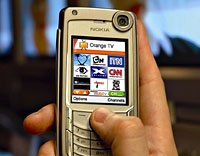 The mobile TV audience soared 45 percent to 3.7 million subscribers in Q2 2006, according to a new report by telecom and new media researchers, Telephia.
The mobile TV audience soared 45 percent to 3.7 million subscribers in Q2 2006, according to a new report by telecom and new media researchers, Telephia. “News and information is the killer app for mobile television. With just a quick flip of their phone it gives consumers instant gratification,” added Gaffney.
“News and information is the killer app for mobile television. With just a quick flip of their phone it gives consumers instant gratification,” added Gaffney. Sony has announced two new cameras shunting off their ever-busy production line, the Sony Cyber-shot DSC-T50 and DSC-N2, both offering large LCD screens.
Sony has announced two new cameras shunting off their ever-busy production line, the Sony Cyber-shot DSC-T50 and DSC-N2, both offering large LCD screens. Shipping in (ahem) ‘bold’ red, black and silver, the DSC-T50 offers 56 MB of internal memory (with Memory Stick Duo/ PRO Duo memory cards allowing storage expansion up to 4GB) and sizes up at just 95×56.5×23.4 and 170g.
Shipping in (ahem) ‘bold’ red, black and silver, the DSC-T50 offers 56 MB of internal memory (with Memory Stick Duo/ PRO Duo memory cards allowing storage expansion up to 4GB) and sizes up at just 95×56.5×23.4 and 170g. Sony DSC-N2
Sony DSC-N2 “With digital photography, the social interaction that happens when people share their pictures has become as important as making great photographs,” insisted Phil Lubell, director of marketing for digital still cameras and photo printers at Sony Electronics.
“With digital photography, the social interaction that happens when people share their pictures has become as important as making great photographs,” insisted Phil Lubell, director of marketing for digital still cameras and photo printers at Sony Electronics.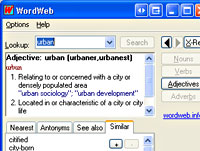 A long time favourite of the Digi-Lifestyles crew, WordWeb is a free, cut-down version of the WordWeb Pro software, and includes a comprehensive English thesaurus and dictionary with the ability to look up words from within external programs.
A long time favourite of the Digi-Lifestyles crew, WordWeb is a free, cut-down version of the WordWeb Pro software, and includes a comprehensive English thesaurus and dictionary with the ability to look up words from within external programs. Simply highlight the word you need a definition for and either click the system tray icon or use the default keyboard shortcut of CTRL+ALT+W.
Simply highlight the word you need a definition for and either click the system tray icon or use the default keyboard shortcut of CTRL+ALT+W.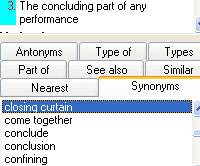 The program can also be used to look up word definitions and alternative synonyms or antonyms – you could, for example, look up “tree”, click on the “Types” tab and you’ll be presented with a list of different types of tree.
The program can also be used to look up word definitions and alternative synonyms or antonyms – you could, for example, look up “tree”, click on the “Types” tab and you’ll be presented with a list of different types of tree.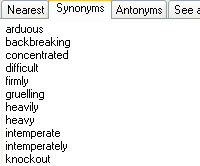 The program – which comes in regionalised flavours – can also access the web to offer a web search of the highlighted word or link to a site with translation capabilities.
The program – which comes in regionalised flavours – can also access the web to offer a web search of the highlighted word or link to a site with translation capabilities.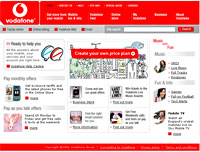 After striking a deal to use infrastructure from BT, mobile phone operator bigwigs Vodafone have announced that they’re ready to play ball amongst the rough and tumble of the UK fixed-line broadband market
After striking a deal to use infrastructure from BT, mobile phone operator bigwigs Vodafone have announced that they’re ready to play ball amongst the rough and tumble of the UK fixed-line broadband market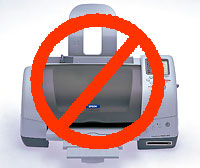 Although I know that shouting at computer components is unlikely to make them magically fix themselves, it somehow makes me feel a bit better.
Although I know that shouting at computer components is unlikely to make them magically fix themselves, it somehow makes me feel a bit better.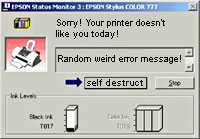 Cursed with a jazz approach to functionality, it’s a moody number with a teenager’s approach to getting up.
Cursed with a jazz approach to functionality, it’s a moody number with a teenager’s approach to getting up. Naturally, the ‘clean heads’ option has little effect (apart from draining £££ inks at an accelerated rate) but just when I’m about to give up on the thing completely – whoosh! out comes a perfect print, with deep blacks and vibrant colours.
Naturally, the ‘clean heads’ option has little effect (apart from draining £££ inks at an accelerated rate) but just when I’m about to give up on the thing completely – whoosh! out comes a perfect print, with deep blacks and vibrant colours.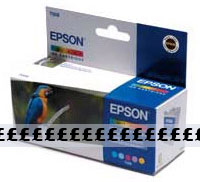 It knows when things are urgent
It knows when things are urgent In 2004 the networking giant Cisco sued a little-known Chinese company called Huawei for IP (Intellectual Property) theft. Some two months later the case was dropped and settled out of court. Huawei promised to modify their designs, change their software and manuals. Rumours circulating at the time alleged that the Chinese government got involved and told Cisco that if they wanted to operate in China, they should leave Huawei alone.
In 2004 the networking giant Cisco sued a little-known Chinese company called Huawei for IP (Intellectual Property) theft. Some two months later the case was dropped and settled out of court. Huawei promised to modify their designs, change their software and manuals. Rumours circulating at the time alleged that the Chinese government got involved and told Cisco that if they wanted to operate in China, they should leave Huawei alone. In China engineering talent is relatively cheap and their universities produce very high class students (and lots of them). This brings Huawei another advantage – huge manpower. When bugs are passed to Huawei, they go to their pool of, something like, 20,000 engineers, leading to the faults being tracked and fixed extremely quickly.
In China engineering talent is relatively cheap and their universities produce very high class students (and lots of them). This brings Huawei another advantage – huge manpower. When bugs are passed to Huawei, they go to their pool of, something like, 20,000 engineers, leading to the faults being tracked and fixed extremely quickly. One thing the Web is great for is reaching out to a potential audience of millions to garner support for your cause.
One thing the Web is great for is reaching out to a potential audience of millions to garner support for your cause. To further promote Tony’s cause the author has invited surfers to sign a petition to register their support, with a form inviting people to enter their name, email address and short comment.
To further promote Tony’s cause the author has invited surfers to sign a petition to register their support, with a form inviting people to enter their name, email address and short comment. Before long, posters had worked out how to add pretty colours to their signatures and then moved on to embedding images.
Before long, posters had worked out how to add pretty colours to their signatures and then moved on to embedding images.